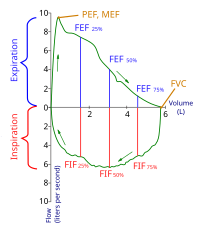
Photo from wikipedia
Summary Background Infrared thermography (IRT) is used to screen febrile passengers at international airports, but it suffers from low sensitivity. This study explored the application of a combined visible and… Click to show full abstract
Summary Background Infrared thermography (IRT) is used to screen febrile passengers at international airports, but it suffers from low sensitivity. This study explored the application of a combined visible and thermal image processing approach that uses a CMOS camera equipped with IRT to remotely sense multiple vital signs and screen patients with suspected infectious diseases. Methods An IRT system that produced visible and thermal images was used for image acquisition. The subjects’ respiration rates were measured by monitoring temperature changes around the nasal areas on thermal images; facial skin temperatures were measured simultaneously. Facial blood circulation causes tiny color changes in visible facial images that enable the determination of the heart rate. A logistic regression discriminant function predicted the likelihood of infection within 10s, based on the measured vital signs. Sixteen patients with an influenza-like illness and 22 control subjects participated in a clinical test at a clinic in Fukushima, Japan. Results The vital-sign-based IRT screening system had a sensitivity of 87.5% and a negative predictive value of 91.7%; these values are higher than those of conventional fever-based screening approaches. Conclusions Multiple vital-sign-based screening efficiently detected patients with suspected infectious diseases. It offers a promising alternative to conventional fever-based screening.
Journal Title: International Journal of Infectious Diseases
Year Published: 2017
Link to full text (if available)
Share on Social Media: Sign Up to like & get
recommendations!